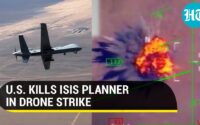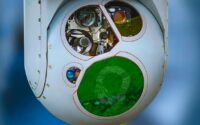A Comprehensive Comparison of Two Revolutionary Technologies
Droids are versatile robots designed for various tasks, from personal assistance to industrial applications, like assembly line tasks and medical support. Drones, on the other hand, excel in aerial photography, surveillance, and delivery services, with the ability to access remote or hazardous areas. Droids operate on the ground, while drones offer unmatched mobility in the air and have limited payload capacity compared to droids.
Droid vs Drone: A Comparison of Two Innovative Technologies
Droids and drones are revolutionizing various industries, but what sets them apart? Let’s compare these innovative technologies.
-
Functionality: Droids, also known as robots, are programmable machines designed to perform tasks autonomously or with minimal human intervention. Drones, on the other hand, are unmanned aerial vehicles (UAVs) controlled remotely or through pre-programmed flight paths.
-
Applications: Droids excel in industries such as manufacturing, healthcare, and logistics, where they can handle repetitive tasks, assist in surgeries, or move goods efficiently. Drones find applications in aerial photography, surveillance, delivery services, and even disaster response, as they can access remote or hazardous areas.
-
Mobility: Droids typically operate on the ground, utilizing wheels or legs for movement. They offer versatility in navigating complex terrains and interacting with the environment. Drones, being airborne, offer unmatched mobility and can cover large distances quickly, providing unique vantage points for observation or transportation.
-
Payload Capacity: Droids can handle heavier payloads due to their sturdy build, making them suitable for tasks requiring strength or manipulation. Drones, while limited in payload capacity, can carry lightweight items such as cameras, sensors, or small packages, enabling various applications.
-
Power Source: Droids are often powered by batteries or connected to a power source, allowing extended operation times. Drones typically rely on batteries, which limit their flight duration. However, advancements in drone technology are increasing flight times through improved battery efficiency and swappable battery systems.
-
Versatility: Droids can be programmed for multiple functions, making them adaptable to various tasks within a specific environment. Drones, though more specialized in their applications, can be equipped with different sensors or payloads to suit specific needs, such as thermal cameras or LiDAR for mapping.
-
Regulations: Drones face strict regulations due to safety and privacy concerns. Many countries require licensing and adherence to flight restrictions. Droids, being primarily ground-based, are subject to fewer regulations but still require compliance with safety protocols in certain industries.
-
Human Interaction: Droids can interact and collaborate with humans, working alongside them or assisting in specific tasks. Drones, being remotely controlled or autonomous, have limited direct human interaction but rely on operators for flight control and mission execution.
Definition and Functionality
Droid – a versatile and intelligent robot designed to assist with various tasks in both personal and industrial settings. With a humanoid appearance, droids are equipped with advanced artificial intelligence and advanced sensory systems, enabling them to perform complex actions and interact with humans.
Drone – an unmanned aerial vehicle (UAV) that is controlled remotely or autonomously. Drones are primarily used for aerial surveillance, photography, and delivery purposes. They are equipped with cameras, sensors, and GPS, enabling them to capture images or videos and navigate through different terrains.
Droid Functionality:
- Personal Assistance: Droids are capable of performing household chores, such as cleaning, cooking, and organizing, making them valuable personal assistants.
- Industrial Applications: In industries, droids are used for assembly line tasks, warehouse management, and hazardous material handling, increasing efficiency and safety.
- Companion and Entertainment: Some droids are designed to provide companionship and entertainment to their owners, engaging in conversations and performing interactive activities.
- Medical Support: Droids assist healthcare professionals in tasks like patient monitoring, medication distribution, and surgical procedures, enhancing precision and reducing errors.
- Educational Tools: Droids can be programmed to teach and assist in educational environments, providing interactive learning experiences to students.
- Exploration and Research: Droids are utilized in space exploration and deep-sea missions, where human presence is limited or risky. They gather data and images to expand our knowledge of the universe and underwater ecosystems.
Drone Functionality:
- Aerial Photography and Videography: Drones capture stunning images and videos from unique perspectives, making them popular among photographers and filmmakers.
- Surveillance and Security: Drones are used for monitoring large areas, enhancing security measures, and providing real-time updates during emergencies or search and rescue operations.
- Delivery Services: Companies employ drones to deliver packages and goods swiftly, particularly in remote or congested areas, reducing delivery time and costs.
- Agricultural Applications: Drones assist farmers in crop monitoring, irrigation management, and pest control, optimizing agricultural processes.
- Infrastructure Inspection: Drones inspect bridges, power lines, and other infrastructure, providing detailed assessments and detecting potential issues or damages.
- Environmental Monitoring: Drones monitor ecosystems, wildlife, and natural disasters, aiding in environmental conservation and disaster response planning.
Design and Physical Characteristics
-
Mobility – Droids, such as BB-8 from Star Wars, possess a spherical shape with a rolling mechanism, enabling them to move smoothly on various terrains. In contrast, drones, like the DJI Phantom, utilize propellers for vertical takeoff, hovering, and agile flight.
-
Size and Form – Droids often exhibit humanoid or animal-like appearances, resembling humans or creatures. They come in varying sizes, from compact astromech droids to taller protocol droids. Conversely, drones typically feature a compact and aerodynamic design, prioritizing efficient maneuverability and stability during flight.
-
Manipulation Capabilities – Droids are frequently equipped with mechanical arms or appendages, allowing them to interact physically with their environment. These appendages enable droids to perform tasks like repairing, carrying objects, or even engaging in combat. On the other hand, drones lack physical manipulation abilities and primarily focus on aerial observations or transport.
-
Power Source – Droids typically rely on batteries or energy cells to operate, ensuring their autonomy and mobility. Some droids may have rechargeable power sources or the ability to plug into external power outlets. Drones, in contrast, utilize rechargeable batteries or even fuel-powered engines, depending on their size and purpose.
-
Sensor Systems – Both droids and drones rely on a variety of sensors to perceive and interact with their surroundings. Droids often have sensors for detecting objects, terrain, temperature, and even human emotions. Drones utilize sensors like GPS, cameras, altimeters, and accelerometers for navigation, obstacle avoidance, and capturing aerial imagery.
-
Communication and Control – Droids are designed to interact with humans and other droids through speech, gestures, or holographic interfaces. They often possess advanced language processing capabilities and can respond to commands or engage in conversations. In contrast, drones rely on wireless communication systems, remote control, or autonomous flight algorithms to receive instructions and transmit data.
-
Payload Capacity – Droids can be designed with the ability to carry or transport objects, making them useful in various industries or even in everyday life. Drones, however, have limited payload capacity due to their primary focus on flight efficiency. They are more commonly used for carrying lightweight cameras or sensors.
Applications
-
Industrial Inspection: Droids – equipped with advanced sensors and cameras, navigate complex industrial environments to inspect pipelines, power lines, and infrastructure, identifying potential issues quickly and accurately. Drones – with their aerial capabilities, survey large areas, assess structural integrity, and provide real-time visual data for preventive maintenance.
-
Delivery Services: Droids – designed for ground-based operations, efficiently deliver packages within urban areas, ensuring faster and cost-effective last-mile delivery. Drones – enable aerial deliveries, particularly useful for remote or hard-to-reach locations, offering speedy transportation of goods, medical supplies, and emergency aid.
-
Agriculture: Droids – equipped with specialized tools, aid in precision farming tasks such as planting, monitoring crop health, and applying targeted treatments, optimizing productivity and reducing environmental impact. Drones – equipped with imaging systems, capture aerial data for crop monitoring, irrigation management, and yield estimation, enabling farmers to make informed decisions.
-
Surveillance and Security: Droids – capable of patrolling restricted areas, monitoring premises, and providing real-time video feeds to security personnel, ensuring enhanced safety and reducing human resource requirements. Drones – offer aerial surveillance, enabling rapid response to emergencies, tracking suspects, and securing large events or critical infrastructure.
-
Entertainment and Filmmaking: Droids – designed for capturing cinematic shots and videos, provide filmmakers with a versatile and mobile camera platform, allowing for unique perspectives and dynamic storytelling. Drones – equipped with stabilized cameras, offer aerial cinematography, capturing breathtaking aerial footage for movies, documentaries, and live events.
-
Environmental Monitoring: Droids – equipped with sensors, contribute to environmental research by collecting data on air quality, water pollution, and wildlife habitats, aiding in conservation efforts and ecosystem preservation. Drones – enable aerial surveys of forests, oceans, and inaccessible areas, facilitating biodiversity studies and monitoring natural disasters.
-
Search and Rescue: Droids – with their maneuverability and ability to access narrow spaces, assist in search and rescue missions, locating survivors in disaster-stricken areas or collapsed structures, minimizing risks for human responders. Drones – equipped with thermal imaging and high-resolution cameras, provide aerial assistance, covering large areas quickly, and aiding in locating missing persons.
Limitations and Challenges
- Autonomy – Droids and drones both face challenges in achieving true autonomy due to technological limitations.
- Payload Capacity – Drones have a greater payload capacity than droids, making them more suitable for transportation and delivery tasks.
- Mobility – Droids often face challenges in navigating complex terrains or confined spaces, while drones can maneuver more freely.
- Energy Efficiency – Droids require a continuous power source, limiting their operational time, while drones can be battery-powered for longer flights.
- Sensory Perception – Droids typically have advanced sensory perception, including tactile abilities, while drones rely on cameras and sensors for perception.
- Remote Control – Drones can be operated remotely, allowing for real-time human control, while droids may require manual operation.
- Legal Restrictions – Drones are subject to strict regulations and airspace restrictions, making their deployment challenging in certain areas.
- Noise Pollution – Drones can generate noise pollution, which may pose challenges in urban areas, while droids can operate silently.
- Safety Concerns – Drones have been associated with safety risks, including collisions and falling objects, while droids are generally safer.
- Weather Conditions – Drones are susceptible to adverse weather conditions, such as strong winds and rain, affecting their performance and flight stability.
- Cost – Drones often require a significant investment in hardware and maintenance, whereas droids can be more cost-effective in certain applications.
- Adaptability – Droids can be designed and programmed for various tasks, making them versatile, while drones are primarily used for aerial operations.
- Human Interaction – Droids can interact with humans more naturally, while drones lack the ability to provide physical assistance or engage in complex conversations.
- Infrastructure – Drones require dedicated landing and charging stations, whereas droids can utilize existing infrastructure and facilities.
- Privacy Concerns – Drones equipped with cameras raise privacy concerns, while droids may be perceived as less intrusive due to their physical presence.
- Ethical Considerations – The use of drones in certain situations, such as surveillance or weaponization, raises ethical dilemmas, unlike droids.
- Maintenance – Drones may require regular maintenance and repairs due to their complex mechanical and electronic systems, while droids can be more straightforward to maintain.
- Public Perception – The presence of drones in public spaces can evoke mixed reactions, whereas droids may be seen as more socially acceptable companions or assistants.
Future Prospects
-
Droids: These humanoid robots possess the ability to perform complex tasks, interact with humans, and adapt to various environments. With their advanced artificial intelligence and dexterity, droids offer immense potential in fields such as healthcare, hospitality, and manufacturing. They can assist in surgeries, provide personalized care to patients, and handle intricate assembly line processes.
-
Drones: These unmanned aerial vehicles have already made a significant impact in sectors like logistics, agriculture, and surveillance. Equipped with high-resolution cameras, sensors, and GPS, drones offer efficient delivery services, crop monitoring, and enhanced security surveillance. The future holds even greater prospects for drones, including urban air mobility, disaster response, and environmental monitoring.
-
Collaboration: The convergence of droids and drones opens up exciting possibilities. Droids can utilize drones as their eyes and hands, enabling them to reach inaccessible areas or perform tasks at a distance. For instance, in disaster scenarios, droids could remotely control drones to assess damage, search for survivors, or deliver essential supplies.
-
Automation: Both droids and drones are at the forefront of automation. As their capabilities evolve, they have the potential to replace human workers in hazardous or repetitive tasks. This shift would free up human resources for more creative and strategic roles, leading to increased productivity and efficiency in various industries.
-
Job Market: The rise of droids and drones may disrupt the job market, leading to changes in employment patterns. While certain jobs may be replaced, new opportunities will emerge in fields such as robotics engineering, drone piloting, and AI programming. To maximize the benefits, upskilling and reskilling programs should be implemented to prepare the workforce for the jobs of the future.



